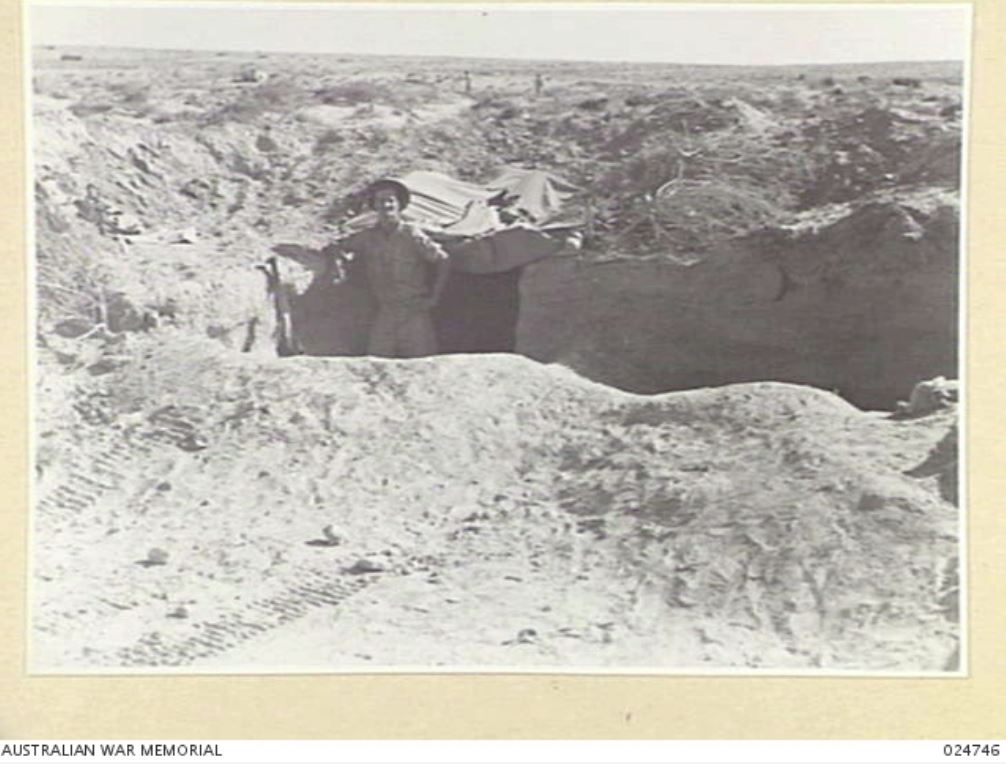2/24th Australian Infantry Battalion
From Our Contribution
 1941 Bianchi, Tobruk - 2/24th soldiers moving forward to take over advanced positions - AWM photo 020075 | |
 1 Aug 1942 Front Line position at Tobruk AWM photo 024746 | |
Contents
[hide]Brief History
Battalion HWs of the 2/24th Australian Infantry Battalion was raised in Victoria Barracks, Melbourne in July 1940 as a part of the 26th Infantry Brigade in the 7th Infantry Division. In August they moved to Wangaratta where they took over three Victoria companies that had been formed at Rokeby. IN September they moved to Bonegilla before departing for the Middle East in November. On their arrival in December they were sent to Dimra in Palestine to train with other 7th Division units. However, in February 1941 along with the rest of the 26th Brigade, they were transferred to the 9th Infantry Division. With the 6th Division sent to Greece, the 9th Division was sent to take over their role in Cyrenaica, while completing their training.
In March 1941 they were sent to Baracca to hold the passes off the Benghazi Plain, However, when the German Afrika Korps led the Axis counter-attack ,the 9th Division fell back to Tobruk - colloquially referred to as the "Benghazi handicap". The 2/24th entered Tobruk on 10 April and helped defend the "fortress" for the next eight months. The 2/24th saw extensive service at Tobruk, manning the Red Line at a number of different locations and participating in the bitter fighting in the Salient, where German forces had the better of them. The battalion was evacuated from Tobruk in the evening of 20 October 1941, returning first to Julis in Palestine to rest and retrain, and then to the Tripoli area of Syria in January 1942. The 2/24th Battalion was located at Madjlaya, before moving to Bech Mezzine in April 1942 for training. In late June the rapid German advance in North Africa saw the 9th Division recalled to the Alamein are 115 km west of Alexandria, with the 26th Infantry Brigade around Amiriya.
When the 26th Brigade moved forward to the El Alamein Box, the 2/24th captured the Tel el Eisa feature, before holding off strong counter attacks. In August they moved into reserve in the El Alamein Box. Following successful defence of the 'box' during July and August, the 26th Brigade had early success in the British break out, before remaining behind to mop up the battlefield while others pursued the retreating Axis forces. They had withdrawn to Palestine by late November re-organising and re-training at Beit Jirja until they returned to Australia in January 1943.
After leave the battalion re-assembled at Kairi in Queensland where they began to prepare for a role in New Guinea. In mid 1943 they began amphibious landing training near Cairns before moving during August to Milne Bay in Papua. Following the initial landings at Lae, and the consolidation of the beach head, the 26th Infantry Brigade landed and began the push towards Lae, reaching the Burep River before moving inland and forcing a crossing over the Busu River. At this point the 2/24th Battalion was detached to help block the Japanese forces seeking to retreat from Lae. In October they rejoined their Brigade in Lae before moving to Finschhafen where they held a defensive position before advancing toward Sattelberg which was occupied by the end of November. The next advance was to Wareo, followed by a short break at Gusika before moving north is support of the advance, protecting and working resupply beachheads before being relieved in late January 1944. At this time they were withdrawn first to Finschhafen, and then sent back to Australia for leave in February 1944.
Reassembling in Ravenshoe, Queensland during May, they trained while waiting for a role to the north of New Guinea. The 1st Australian Corps, of which the 9th Division was a part was assigned the role of liberating Borneo, with the 9th Division to undertake landings at Tarakan Island at at Brunei Bay. During March and April the 2/24 Battalion moved to Morotai Island before participating in the second wave of troops ashore, securing the beach head and then advancing towards the airfield and the Juata oilfield. Early capture of the main areas was followed by 6 weeks of mopping up Japanese troops determined to fight on, with the last Japanese resistance ceasing withthe overall Japanese surrender.
Battalion Personnel
- David Deverell 7 May - 12 Jun 1945 WIA
Battle Honours
- North Africa 1941-42
- Defence of Tobruk
- The Salient 1941
- Defence of Alamein Line
- Tel el Eisa
- El Alamein
- South West Pacific 1943-45
- Lae-Nadzab
- Busu River
- Finschhafen
- Sattelberg
- Wareo
- Liberation of Australian New Guinea
- Wareo-Lakona
- Borneo
- Tarakan
Individual Honours
- 1 x Distinguished Service Order & Bar
- 3 x Distinguished Service Orders
- 2 x Officer of the Order of the British Empire
- 3 x Member of the Order of the British Empire
- 12 x Military Cross
- 8 x Distinguished Conduct Medal
- 21 x Military Medal
- 1 x British Empire Medal
- 35 x Mentioned in Despatches
Notes
Content has come from The Unit Guide - Volume 2 - The Australian Army 1939-1945, pages 2.318 to 2.320 - Graham R McKenzie-Smith - Big Sky Publishing - 2018 & the Australian War Memorial website accessed 16 Sep 2020.